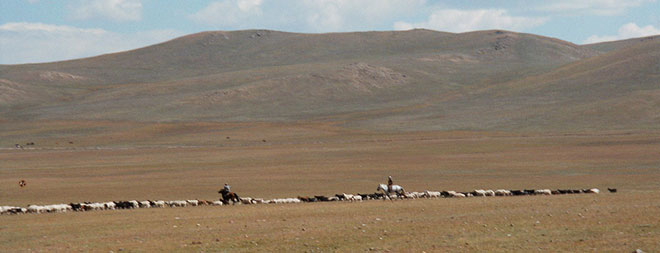Climate Alters Mongolian Past And Present

(ISNS) -- The drought that devastated Mongolia in the early part of the last decade killed tens of millions of livestock, forcing hundreds of thousands of people to flee the countryside and seek new lives in the capital city of Ulaanbaatar — a shift that has been transforming the country ever since.
Researchers now know that the drought was the hottest of the last 1,000 years and was likely exacerbated by global warming.
As global temperatures continue to rise this type of severe drought could become more frequent, with potentially drastic consequences to central Asia, according to researchers.
The new analysis is part of a larger study, which found that unprecedented rainfall in the 13th century gave Genghis Khan the resources to turn the Mongolian Empire into the largest land empire in history, spanning vast stretches of Asia and Eurasia.
Together, the studies of wet and dry periods in 13th-century and modern Mongolia point to the way abrupt, decade-scale climate shifts can alter the fates of societies — for better or for worse.
"They'll precipitate or catalyze rapid social change," said Amy Hessl of West Virginia University in Morgantown and one of the lead authors of the new study, published in the March 10 issue of the Proceedings of the National Academy of Sciences.
Although this study of the Mongolian Empire has been reported previously, the newly published work represents the researchers' completed analysis.
Get the world’s most fascinating discoveries delivered straight to your inbox.
Mongolia is a traditionally nomadic society, in which 40 percent of the work force depends on livestock, according to the World Bank. The shift to a capitalist economy in the 1990s led to even more investment in livestock, Hessl said.
But, between 1998 and 2002, three consecutive dzuds — severe winters made worse by a preceding drought — killed 20 million livestock. The especially harsh dzud in 2010 killed 20 percent of the nation's livestock population, or 8.5 million animals.
The unrelenting dzuds sent the rural population flooding into the cities, primarily Ulaanbaatar. In 2010, 68 percent of Mongolians lived in urban areas, compared to 57 percent in 2000. The population of Ulaanbaatar ballooned by 300,000 since 2000, and now sits at 1.2 million. About 60 percent of the city's population has settled in traditional Mongolian tents called gers, forming massive ger districts —without paved roads, electricity, sanitation, or running water.
The researchers analyzed tree rings of Siberian pines, which can live up to a thousand years, to reconstruct a 1,112-year history of soil moisture and climate in Mongolia — one of the longest tree-ring histories on record. More rain means moister soil, which causes trees to grow faster and produce thicker tree rings.
Combining their data with previously published tree-ring records, they found that the severity of the recent drought was matched only by dry periods in the late 12th century, which may have contributed to the political instability from which a strong, charismatic leader like Genghis Khan could emerge. The fact that the 21st century has been much warmer than it was in the past means that recent temperature increases likely worsened the drought's impact.
The researchers' tree-ring record also revealed a time of unprecedented rainfall between 1211 and 1225, coinciding with the expansion of the Mongolian Empire. While some scholars suggest that droughts pushed the Mongols to invade other lands, this is the first evidence to suggest that rain fueled their conquests.
"Contrary to conventional wisdom, the Mongol Empire expanded under a very warm and particularly wet period," Hessl said. "This climate would have benefitted the Mongols by providing them with ample grassland productivity." This productivity was crucial for providing a consistent energy source for horses and livestock to support armies.
To determine that tree-ring data was an accurate representation of grassland productivity, the researchers compared their tree-rings to satellite data of vegetation covering Mongolia between 1980 and 2010. Making this link is important, showing that the evidence isn't simply coincidental, said Valerie Trouet of the University of Arizona in Tucson, who was not part of the research.
"This work opens up new trains of thought in terms of what drives human migration and the extension of past empires," said Trouet, whose research showed that abrupt climate shifts played a role in the fall of the Roman Empire. For example, she said, one hypothesis is that grassland productivity in central Asia also fueled the Huns, who invaded the Roman Empire in the 5th century A.D.
Although modern societies tend to be more resilient against rapid climate shifts, today's Mongolia shows that's not always the case. "The changes that are ongoing in climate now are very often very abrupt," Trouet said. "And that makes it harder to adapt."
Inside Science News Service is supported by the American Institute of Physics. Marcus Woo is a freelance science writer based in the San Francisco Bay Area who has written for National Geographic News, New Scientist, and other outlets.


